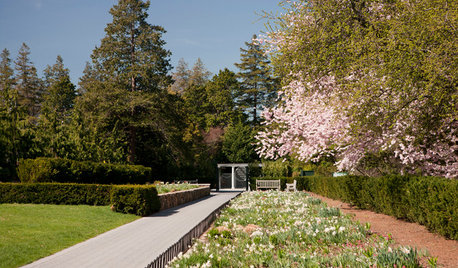Mt Laurel cultivars info
poaky1
12 years ago
Related Stories

INSPIRING GARDENSA Spring Walk Through Piet Oudolf’s New Garden in the Bronx
This lush expanse of bulbs, perennials and grasses at The New York Botanical Garden is showing its color. Have a look
Full Story
GARDENING GUIDESGarden-Friendly Native Alternatives to Overplanted Exotics
There are lots of gorgeous, wildlife-friendly native plants ready to make an appearance in your garden
Full Story
GARDENING GUIDESGreat Garden Combo: 3 Wonderful Plants for a Deer-Resistant Screen
Protect your privacy and keep deer at bay with a planting trio that turns a problem garden area into a highlight
Full Story
SIDE YARD IDEASNarrow Trees for Tight Garden Spaces
Boost interest in a side yard or another space-challenged area with the fragrance and color of these columnar trees
Full Story
GARDENING FOR BUTTERFLIES3 Ways Native Plants Make Gardening So Much Better
You probably know about the lower maintenance. But native plants' other benefits go far beyond a little less watering and weeding
Full Story
REMODELING GUIDESWhat to Know Before You Tear Down That Wall
Great Home Projects: Opening up a room? Learn who to hire, what it’ll cost and how long it will take
Full Story
GARDENING GUIDES5 Best-Behaved Trees to Grace a Patio
Big enough for shade but small enough for easy care, these amiable trees mind their manners in a modest outdoor space
Full Story
GARDENING GUIDESTop 12 Summer-Blooming Perennials for Deer-Resistant Drama
Can you have garden color, fragrance and exciting foliage with hungry deer afoot? These beauties say yes
Full Story
TREES7 Deer-Resistant Flowering Trees to Plant this Fall
If you live in a neighborhood with roaming deer, consider these beautiful trees that won't tempt hungry guests
Full Story
FALL GARDENING9 Deer-Resistant Flowering Shrubs to Plant This Fall
These exquisite shrubs will attract your attention but won’t tempt the deer that roam your neighborhood at night
Full StorySponsored






mainegrower
poaky1Original Author
Related Professionals
New Bedford Landscape Architects & Landscape Designers · Bellflower Landscape Architects & Landscape Designers · Richmond Heights Landscape Architects & Landscape Designers · Saint Louis Park Landscape Architects & Landscape Designers · Taylorsville Landscape Architects & Landscape Designers · Washington Landscape Architects & Landscape Designers · Bellefontaine Neighbors Landscape Contractors · Biloxi Landscape Contractors · East Hanover Landscape Contractors · Goodlettsville Landscape Contractors · Olympia Landscape Contractors · Siloam Springs Landscape Contractors · Smyrna Landscape Contractors · Tigard Landscape Contractors · West Haverstraw Landscape Contractorsmainegrower
rhodyman
poaky1Original Author
botann
poaky1Original Author
botann
rhodyman
poaky1Original Author
poaky1Original Author
Iris GW
jimmy2010